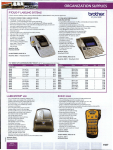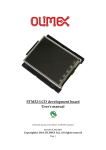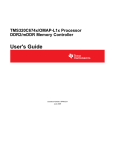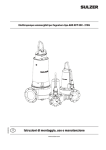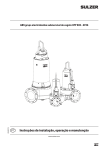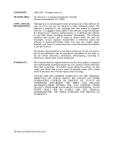Download Fluke HART 744 User's Manual
Transcript
® 744 Documenting Process Calibrator HART Mode Users Guide PN 691292 December 1998 © 1998 Fluke Corporation, All rights reserved. Printed in U.S.A. All product names are trademarks of their respective companies. Table of Contents Title Introduction ..................................................................................................................... How to Contact Fluke ..................................................................................................... Connecting to a HART Transmitter ................................................................................ Supported vs. Generic Transmitters ............................................................................... Communication Operations ............................................................................................ Viewing Process Variables ........................................................................................ Setup Operations ....................................................................................................... Basic ..................................................................................................................... Sensor................................................................................................................... Device Identification .............................................................................................. HART Output ........................................................................................................ HART Information ................................................................................................. Service Operations .................................................................................................... Abort Softkey ............................................................................................................. Interaction between Analog Mode and HART Mode ...................................................... Understanding HART Calibration ................................................................................... 744 HART Mode Menus for Adjustment......................................................................... i Page 1 2 3 6 8 8 8 8 10 10 11 11 12 12 12 13 13 744 HART Mode Users Guide Calibrating a Supported HART Transmitter .................................................................... Loop Test.................................................................................................................... Output Trim................................................................................................................. Sensor Trim ................................................................................................................ Cloning a Transmitter ...................................................................................................... Index ii 15 16 17 17 19 List of Tables Table 1. Title Page Supported vs. Non-Supported Instruments............................................................................ 7 iii 744 HART Mode Users Guide iv List of Figures Figure 1. 2. 3. Title Page Connecting to a HART Transmitter........................................................................................ 5 744 HART Mode Menu Tree.................................................................................................. 9 Block Diagram of a HART Transmitter .................................................................................. 14 v 744 HART Mode Users Guide vi Documenting Process Calibrator HART Mode Introduction w Warning To avoid electric shock, read the Safety Information in the 744 Users Manual before you use the Fluke 744 Documenting Process Calibrator. With analog transmitters, you must make a hardware adjustment during calibration. With HART (HighwayAddressable Remote Transducer) transmitters, adjustments are by remote command. These adjustments require the use of a communication tool as well as a calibrator. The Fluke 744, hereafter called “calibrator,” provides communication and calibration functions in one tool. This manual describes how to use HART mode, which is active when the calibrator is communicating over its serial HART interface to a HART transmitter. Refer to the 744 Users Manual for safety, analog mode operating instructions, specifications, and other general information. All of the calibrator functions described in the 744 Users Manual are available and can be used with HART transmitters. The only transmitters addressed in this manual are HART transmitters. 1 744 HART Mode Users Guide How to Contact Fluke To contact Fluke, call: USA and Canada: 1-888-99-FLUKE (1-888-993-5853) Europe: +31 402-678-200 Japan: +81-3-3434-0181 Singapore: +65-*-276-6196 Anywhere in the world: +1-425-356-5500 Or visit us on the World Wide Web: www.fluke.com 2 Documenting Process Calibrator HART Mode Connecting to a HART Transmitter Connecting to a HART Transmitter 4. To connect to and begin to communicate with a HART transmitter, refer to Figure 1 and proceed as follows: The calibrator provides loop power through an internal series resistance of 250 Ω. Note If you only want a communication connection to a transmitter that is powered in a loop, simply clip the HART alligator clips to the loop power terminals on the transmitter, press r, and you are done. 1. Connect the calibrator mA jacks to the loop power terminals of the transmitter. 2. Plug the HART interface cable into the SERIAL PORT, then connect the alligator clips to the same terminals as in step 1. There is no right or wrong polarity. 3. Press the r key. Note The square-root symbol on r key is there only for calculator mode. At all other times, there is no square-root function associated with the r key. If the transmitter is not powered by a loop power supply, press the Loop Power softkey to activate 24V loop power. Note If the calibrator shows a measurement of 0 mA, check for reversed current leads. If an external loop power supply is used, there must be a resistance of between 230 Ω and 270 Ω connected in series with the external loop supply and the transmitter. 5. The calibrator tries Poll Address 0 (single transmitter per loop). If no connection is made, press the Poll softkey to scan Poll Addresses 1 through 15 (multidrop). 6. Once the calibrator establishes communication with the transmitter, the Active Device screen appears. In the case of a multidrop configuration, you must choose a transmitter from a list, and press e. 3 744 HART Mode Users Guide The Active Device screen provides the following information for all transmitters, supported or generic: pe06s.bmp 4 • • • • • • Poll address (if not 0) Model number and Tag ID PV (Primary Variable) PVAO (digital representation of the Analog Output) PV LRV (PV Lower Range Value) PV URV (PV Upper Range Value) • Softkeys for accessing HART operation menus Documenting Process Calibrator HART Mode Connecting to a HART Transmitter 744 MEAS SOURCE 7 4 9 5 -PS +PS M -IN +IN SETUP CLEAR S Z ( ZERO) 6 2 3 ENTER . 0 mA RTD Transmitter TC RTD 8 1 V RTD mA V Hz V DOCUMENTING PROCESS CALIBRATOR mA V RTD CAT 30V MAX SOURCE 30V MAX MEAS 30V MAX 300V MAX TC pe01c.eps Figure 1. Connecting to a HART Transmitter 5 744 HART Mode Users Guide Supported vs. Generic Transmitters The calibrator communicates with virtually all HART transmitters. In addition, the calibrator is programmed to use device-dependent commands for a selection of HART transmitters and their software versions. These are “supported transmitters.” All other transmitters are “generic.” 2. If the calibrator is not connected to a HART transmitter, press the r key followed by More Choices. 3. Press the Device Revs softkey. The Browser screen appears. Table 1 shows the operations that are available for supported vs. generic transmitters in single point and multidrop configurations. Note Sensor trim is provided for supported transmitters, with a few exceptions, as identified in the list of supported transmitters that you can view on the display. pe07s.bmp 4. Press u or d to highlight the desired manufacturer, and press e. A list of model numbers appears. 5. Press u or d to highlight the model number, and press e. A list of software versions appears. To display a list of supported transmitters and software versions: 1. 6 If the calibrator is connected to a HART transmitter with the Active Device screen showing, press the Abort softkey, followed by More Choices. Documenting Process Calibrator HART Mode Supported vs. Generic Transmitters Table 1. Supported vs. Generic Transmitters (Devices) Menu Operation Supported Transmitter Generic Transmitter Single Point Multidrop Single Point Multidrop Top Level Active Device screen • • • • Setup Basic (read/write, cloning capability) • • • • Sensor (read only) • • • • Device Identification (read/write) • • • • HART Output (read/write) • • • • HART Information (read only) • • • • Loop Test • Not Available • Not Available Pressure Zero Trim • • • • Output Trim • Not Available • Not Available Sensor Trim • • Not Available Not Available Detailed process information • • • • Service Process 7 744 HART Mode Users Guide Communication Operations Setup Operations Figure 2 shows the HART Mode menu tree. Availability of some elements in the menus depends on which transmitter you are using, and whether the transmitter is configured by itself on a current loop or in a multidrop connection. The Setup softkey provides access to the following five setup functions: Viewing Process Variables From the Active Device screen press the Process softkey to view more device variables and their continuously updated values. To see additional information, press the Next Page softkey. • • • • • Basic Sensor Device Identification HART Output HART Information Basic From the Active Device screen press the Setup and Basic softkeys to access the read/write Basic Setup screen. You can use this screen to clone a transmitter as described at the end of this manual. pe08s.bmp pe09s.bmp 8 Documenting Process Calibrator HART Mode Communication Operations PROCESS (Example) PV % Range AO SV, TV, QV Basic • • • • • Tag PV units LRV, URV Damping Transfer function • • • • • • Software version Final assembly number Tag Message Date Description Sensor Device Identification SETUP Loop test SERVICE HART Output Pressure zero trim Output trim Sensor trim HART Information • • • • • • Manufacturer Model Device HART ID Software revision Hardware revision Number of preambles • • Sensor serial number Sensor lower and upper limits • Sensor minimum span (temperature devices only) • Sensor type • Sensor connections • • • • • Write protect Alarm state HART poll address HART burst mode HART burst command ABORT pe03f.eps Figure 2. 744 HART Mode Menu Tree 9 744 HART Mode Users Guide Sensor Device Identification From the Active Device screen press the Setup and Sensor softkeys to access the read-only Sensor Setup screen. This is where you can view information about the sensor in the transmitter, including serial number, limits, and span. The limits shown are the absolute limits for the sensor. (The Upper Range Value (URV) and Lower Range Value (LRV) are different, and are viewable and programmable through the Basic Setup screen.) From the Active Device screen press the Setup and Device Identification softkeys to view information about the transmitter. You can program the Tag, Message, Date, and Descriptor registers in the transmitter using this screen. pe11s.bmp pe10s.bmp 10 Documenting Process Calibrator HART Mode Communication Operations HART Output HART Information From the Active Device screen press the Setup and HART Output softkeys to access the read/write HART Output From the Active Device screen press the Setup and HART Information softkeys to access the read-only HART screen. Here you can change the Poll Address (0 = single transmitter, any other address = multidrop), and control burst mode. Information screen. This screen shows more complete information about the transmitter model, hardware and software revision numbers, and how many preambles it sends. pe12s.bmp pe13s.bmp 11 744 HART Mode Users Guide Service Operations The Service softkey provides access to Loop Test, Pressure Zero Trim (where applicable), Output Trim, and Sensor Trim operations. For generic transmitters, only Loop Test, Output Trim, and Pressure Zero Trim are available. (See Table 1.) The trim (adjustment) operations are described later in this manual. Note Loop Test and Output Trim are not available if the transmitter is in multidrop mode. Interaction between Analog Mode and HART Mode Analog mode is normal calibrator operation, as described in the 744 Users Manual. HART mode is activated when you press the r (HART) key. This action starts communication over the HART interface. You can switch between HART and analog modes easily by pressing r (or pressing M to go to analog mode from HART mode), gaining the benefit of having the transmitter automatically,set up analog mode for appropriate measure and source functions, if desired. Abort Softkey The Abort softkey terminates the communication operation underway, and returns control to the previous screen. From the Active Device screen, Abort calls up the browser, in which you can view the list of supported transmitters. For supported transmitters, the transition to analog mode goes to the MEASURE/SOURCE screen, which provides an easy way to proceed with an “as found” calibration. For generic transmitters, the transition to analog mode involves choosing the MEASURE or SOURCE screen, from which you select the appropriate function. For supported or generic transmitters, when you press r to return to HART mode, the Active Device screen is displayed. The HART serial communication connection remains active as you switch between HART and analog modes. 12 Documenting Process Calibrator HART Mode Understanding HART Calibration Understanding HART Calibration 744 HART Mode Menus for Adjustment An analog transmitter has one stage of electrical conversion from a measured physical parameter to a 4-20 mA current loop output. A HART transmitter has the three stages shown in Figure 3. In 744 HART mode, adjusting the Input stage is called Sensor Trim. Adjusting the Output stage is called Output Trim. Both adjustments are made from the Service menu. Depending on how the transmitter is used in your application, you may need to test and adjust the Input stage, the Output stage, or both. For example, if your application requires the Primary Variable (PV) to be correct when read by a host computer, you must calibrate the Input stage. For pressure transmitters, there is another adjustment, called Pressure Zero Trim. This adjustment is the same as trimming the lower sensor point at zero. All three operations are run from the 744 HART mode Service menu. If your application requires that the 4-20 mA current output value accurately reflect what the Input stage is measuring, you must calibrate both the Input and Output stages. Transmitters in multidrop systems, in which more than one is wired in parallel, do not use their Output stages at all. Their analog outputs are all held at an idling level of 4 mA no matter what the Input stage is measuring. 13 744 HART Mode Users Guide 744 Calibrator Sensor trim Pressure zero trim Physical variable Input PV PVAO Computation Loop test Output trim Output 4-20mA loop HART transmitter pe02f.eps Figure 3. Block Diagram of a HART Transmitter 14 Documenting Process Calibrator HART Mode Calibrating a Supported HART Transmitter Calibrating a Supported HART Transmitter An “as found” and “as left” transmitter calibration has an easier, more automated process for HART transmitters than for analog transmitters. The calibration procedure is the same as described in the 744 Users Manual, except for how you set up the calibration template, and how you adjust the transmitter. Note If you are starting a calibration procedure from a loaded Task, connect to the HART transmitter first and establish communication before you press Task in analog mode. The following procedure assumes that you are familiar with using a 740 Series Documenting Process Calibrator to calibrate analog transmitters, and are not running a loaded Task. 1. 2. Make the appropriate measuring, sourcing, and HART interface connections between the calibrator and the transmitter, and press r to establish communication. Press r to switch to analog mode. pe14s.bmp 3. You are presented with a set of choices for analog mode. Use the u and d keys to select one of the measure/source choices. This is where you select measure mA (analog output), or measure PV, which does not involve the Output stage of the transmitter. See Figure 3. 4. Press e. 5. Press the As Found softkey. 6. Use the u and d keys followed by e to select an instrument calibration procedure. You’ll see that the calibration template is preloaded with appropriate data. You can make changes to any item if you wish. 15 744 HART Mode Users Guide 7. Proceed with calibration as usual (described in the 744 Users Manual). 8. Press the Adjust softkey. This returns you to HART mode, and presents you with the Service menu for the transmitter. 9. Do an Output Trim, a Sensor Trim, or both. These are Service Operations, and are described later in this manual. When you have finished with the trim procedures, press the Done softkey. 10. Press the As Left softkey and repeat the calibration procedure to verify that the transmitter passes. Loop Test The Loop Test feature sends a command to the transmitter to set its output stage to a specified value. Use this to check the calibration of the output stage, or to check for proper reading on an external loop reading device. To perform a Loop Test: 1. 16 From the Active Device screen Press the Service softkey, followed by Loop Test. pe15s.bmp 2. Press a softkey to command the transmitter to set its analog output to the corresponding value, or manually enter a value with the numeric keys. In the middle of the screen the transmitter acknowledges the selected PVAO (digital representation of the Output stage). The calibrator shows the measured value at the top of the screen, so you can use Loop Test as a quick way to check the calibration of the transmitter’s Output stage. Documenting Process Calibrator HART Mode Calibrating a Supported HART Transmitter Output Trim Sensor Trim An Output Trim adjusts the tranmitter’s Output stage. You can perform an Output Trim on both generic and supported transmitters. You can only perform a Sensor Trim on a supported transmitter. A Sensor Trim adjusts the Input stage of a HART transmitter. If your application does not use the Output stage of the transmitter, Sensor Trim is the only adjustment you need to make. To perform an Output Trim: 1. From the Active Device screen Press the Service softkey, followed by Output Trim. A Sensor Trim may involve one or more trim points. This is controlled by the transmitter’s software. You can only perform a Sensor Trim on a supported transmitter. To perform a Sensor Trim, proceed as follows: 1. From the Active Device screen, press the Service softkey, followed by Sensor Trim. pe16s.bmp 2. Press Fetch to load the mA value being measured by the calibrator into the dialog box. 3. Press Send to trim the low analog output point. 4. To trim the high analog output point, repeat steps 2 and 3, following the prompts on the display. pe17s.bmp 17 744 HART Mode Users Guide 2. Use the u and d keys to select the Sensor Trim operation, and press e. 3. 4. 5. Follow the instructions on the display. For pressure, there is a message to connect a pressure module to the calibrator, and another to press the c key to zero the pressure module. Enter the trim value you want the calibrator to produce, and press e, or in the case of a pressure transmitter (as above), press Fetch to load the value being measured by the Fluke pressure module into the dialog box. 6. Press Trim. Press Continue. 7. If prompted to do so, repeat steps 2 and 3, following the prompts on the display, to trim the remaining points. Note Select trim points near the range limits unless the transmitter’s documentation specifies otherwise. pe18s.bmp 18 If you get an error message that for the selected trim point there is an excess correction, sometimes you can solve the problem by doing a series of Sensor Trims in small steps from the previous trim point toward the desired trim point. Documenting Process Calibrator HART Mode Cloning a Transmitter Cloning a Transmitter 4. Press the Store Page softkey to load the settings into the calibrator’s memory (not the transmitter). Cloning copies the Basic Setup information from one transmitter to another. You can clone generic and supported transmitters. 5. Disconnect the calibrator from the transmitter and connect it to the transmitter you want to configure. Press the Abort softkey to establish communication. 6. Press the Setup softkey, then select Basic to return to the Basic Setup screen. 7. Press the Recall Page softkey to refresh the calibrator display with the cloned parameter settings. The settings are not transmitted to the transmitter at this time. 8. Use the u or d and ekeys to select parameters one at a time, change them, or leave them as cloned, and press the Send softkey to transmit them to the transmitter. To use the calibrator to clone a transmitter: 1. Connect the calibrator to the transmitter you want to clone. You only need a communication connection. 2. From the Active Device screen, press the Setup softkey. 3. Use the u or d keys to select Basic from the list on the screen and press e. pe09s.bmp 19 744 HART Mode Users Guide 20 Index —A— —D— —I— abort, 12 active device screen, 4 analog mode, 12 as found, 15 as left, 15 device identification, 10 input stage, 13 —E— external series resistor, 3 —B— —G— basic setup, 8 browser screen, 6 generic transmitters, 6 —C— calibrating a HART transmitter, 15 cloning, 19 communication test leads, 3 —L— loop power, 3 loop test, 16 LRV, 4 —M— —H— HART information, 11 HART mode, 12 HART output, 11 model numbers, 6 multidrop, 8, 13 21 744 HART Mode Users Guide —O— —R— output stage, 13 output stage, 16 output trim, 13, 17 recall page, 19 software versions, 6 store page, 19 supported transmitters, 6 —S— —T— sensor, 10 sensor trim, 13, 17 serial communication, 3 series resistor, 3 service operations, 12 setup basic, 8 device identification, 10 HART information, 11 HART output, 11 sensor, 10 task, 744, 15 telephone numbers for Fluke, 2 trim output, 13, 17 pressure zero, 13 sensor, 13, 17 —P— phone numbers for Fluke, 2 pressure module, 18 pressure zero trim, 13 process variables, 8 PV, 4 PVAO, 4, 16 22 —U— URV, 4































